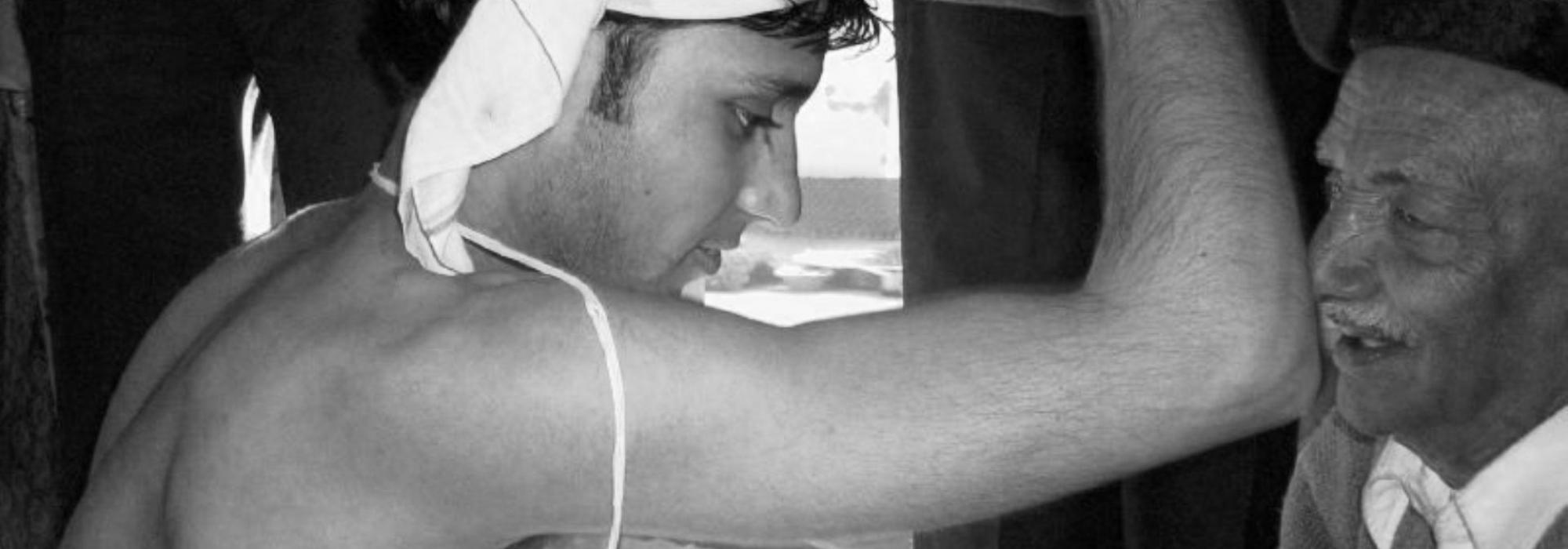மேகலை அணிவித்தபின் அச்சிறுவனுக்கு பூணூல்(யக்ஞோபவீதம்) அணிவிக்கப்படுகிறது.[1] யக்ஞோபவீதம் என்பது பவித்திரமான பூணூல் என்று இப்போதை உள்ளதைப்போல அப்போதெல்லாம் கருதப்பட்டு வந்ததாகத் தெரியவில்லை[2], எனினும் பிற்காலங்களில் இதுவே உபநயன சடங்கில் கவனத்துக்குரிய பிரதான கட்டமானது.[3] பிற்காலங்களில் இளம் வடுவுக்குப் பூணூலை வழங்கி அவனை, "யக்ஞோபவீதம் பரமம் பவித்ரம்", என்கிற பிரபலமான வரியை உச்சரிக்கச் செய்தார்கள்.[4]
கலியாணமாகாத பிராம்மண கன்னி நெய்ந்த நூல்களைக்கொண்டு பூணூல் தயாரிக்கப்படுகிறது. ஒரு பிராம்மணன் இந்நூல்களை முறுக்கேற்றுகிறான். பூணூலில் இடம்பெறும் முடிச்சுக்கள் அச்சிறுவனது கோத்திரத்திலுள்ள(பரம்பரையிலுள்ள) பிரபல மூதாதையர்களின் எண்ணிக்கையை ஒத்தமையும். பூணூல் என்பது (ஒவ்வொரு நூலும்) நன்கு முறுக்கேற்றப்பட்ட ஒன்பது இழைகளாலான மூன்று நூல்களைக் கொண்டது.[5] இந்த ஒன்பது இழைகளுக்கான (tantus) ஒன்பது தேவதைகளாவன – Omkāra, Agni, Nāga, Soma, Pitṛs, Prajāpati, Vāyu, Sūrya, மற்றும் Viśvedevas.[6] வெவ்வேறு இஷ்டிகளும் (iṣṭis) மற்றும் யக்ஞங்களைப் பொருத்து, நூல் மற்றும் இழைகளின் எண்ணிக்கை வேறுபடும்.[7]
பூணூல் தயாரிக்கும் முறையில்கூட ஒரு சில அடையாளங்கள் பொதிந்து கிடக்கின்றன. பூணூலை ஒவ்வொரு சிறுவனுக்கும் பிரத்யேகமாக தயாரிப்பதே வழக்கம். பூணூல் அணிபவரது நான்கு விரல்களின் அகலத்தைவிட தொண்ணூற்றாறு முறை நீளம் உடையதாக அமைந்திருக்க வேண்டும். நான்கு வரல்கள் நால்வகை உணர்வு நிலைகளைக் குறிக்கின்றன – jāgarita (முழிப்பு நிலை), svapna (கனவு நிலை), suṣupti (ஆழ் உரக்க நிலை), மற்றும் turīya (அனைத்திலும் வியாபித்திருக்கும் ஒருவரது மெய் நிலை).
கயிற்றிலுள்ள மூன்று மடிப்புக்கள் முக்குணங்களின் அடையாளம்-சத்வம்(அகத்தூய்மை நிறைந்த நற்குணங்கள்), ரஜஸ்(அமைதியற்ற நடவடிக்கைகள்), மற்றும் தமஸ்(ஏமாற்றம்தரும் சோம்பல்). சத்வம் பாக்கி இரண்டைவிட மேலோங்கி இருக்க வேண்டும் என்பதால் பூணூல் மேல்நோக்கித் திருகப்பட்டிருக்கும்.
இம்மூன்று கயிறுகள், ரிஷிகள், தேவர்கள் மற்றும் பித்ருக்களுக்கான மூவகை கடன்களை(ṛṇas) பூணூல் அணிந்திருப்பவன் நினைவில் கொள்ள வேண்டும் என்பதற்கான அறிகுறியாகவும் விளங்குகின்றன. பிரம்மசாரி மற்றும் பிரம்மசரியம் என்கிற வார்த்தைகள் அடங்கிய மூவகை ருணங்களை குறித்த வேதத்தின் பிரபலமான வரிகள்[8] இதோ-"பிறக்கும்போது ஒவ்வொரு பிராம்மணனும் மூவகையிலான கடன்களுடன் பிறக்கிறான்:பிரம்மசாரியாக ஆசாரியருடன் வாழும்போது ரிஷிகளுக்கும், யக்ஞத்தினால் தேவர்களுக்கும், மகனை ஈன்றெடுப்பதால் பித்ருக்களுக்குமான இக்கடன்களை அடைக்கிறான்."[9]
இம்மூன்று கயிறுகளையும் 'பிரம்மமுடிச்சு' இணைக்கிறது. இது பிரம்மா, விஷ்ணு, மற்றும் சிவனைக் குறிக்கும்.
ஆசாரியர் பூணூலை சிறுவனுக்கு வழங்கும்போது, அவனுக்கு வலிமை, நீண்ட ஆயுள், மற்றும் வீரியம் கிட்ட வேண்டும் என்று பிரார்த்தித்து மந்திரம் ஓதுகிறார்;[10] அந்த சமயத்தில் அச்சிறுவன் சூரியனைப் பார்க்க வேண்டும். உபநயனத்தின்போது பிரம்மசாரிக்கு (மூன்று கயிறுகளாலான) ஒரு ஜோடி பூணூல் வழங்கப்படுகிறது. கிருஹஸ்தனுக்கு இரு ஜோடி பூணூல் அணியும் தகுதி உண்டு(பொதுவாக மணமேடையில் இது வழங்கப்படுகிறது).
அந்தந்த சூழலுக்கேற்ப பூணூல் வெவ்வேறு விதத்தில் அணியப்படுகின்றது. இயற்கை கடன்களைக் கழிக்கும்போதும், பிணம் தூக்கும்போதும், கலவியின்போதும், ரிஷி-தர்ப்பணத்தின்போதும், தமது குழந்தைகளுக்கான ஒரு சில சடங்குகளைச் செய்யும்போதும், மேலும் ஆடவருக்கான பிரத்யேக வேலைகளைச் செய்யும்போதும் பூணூலை நிவீதமாக(கழுத்தைச்சுற்றி மாலையாக) அணிந்திருக்க வேண்டும்.[11] மங்களகரமான சடங்குகளின்போதும், சாதாரண நாட்களிலும் பூணூலை உபவீதமாக(இடது தோள்பட்டையிலிருந்து தொடங்கி உடலின் குறுக்கே) அணிந்திருக்க வேண்டும். அந்திம சம்ஸ்காரம் அல்லது சிரார்தம் செய்யும்போது பூணூலை பிராசீனாவீதமாக(வலது தோள்பட்டையிலிருந்து தொடங்கி உடலின் குறுக்கே மற்றொரு புறமாக) அணிந்திருக்க வேண்டும்.
அதாவது, மனிதர்களுக்கான காரியங்களை செய்யும்போது அவன் நிவீதன் ஆகிறான்; தேவர்களுக்கான காரியங்களை செய்யும்போது அவன் உபவீதன் ஆகிறான்; பித்ருக்களுக்கான காரியங்களை செய்யும்போது அவன் பிராசீனவீதன் ஆகிறான்.[12]
சித்திரப்பூர்வமாகக் கூறுவதாயின், மாலையைப்போன்று கழுத்தை சுற்றி பூணூல் அணிந்திருக்கும்போது அவன் நிவீதன் ஆகிறான். வலக்கையால் பூணூலை எடுத்து, அதனை தலைக்கு மேல் தூக்கி, தனது இடது தோள்பட்டையிலிருந்து உடலின் வலப்புறம் படருமாறு செய்துகொள்ளும்போது அவன் உபவீதன் ஆகிறான். இடக்கையால் பூணூலை எடுத்து, அதனை தலைக்கு மேல் தூக்கி, தனது வலது தோள்பட்டையிலிருந்து உடலின் இடப்புறம் படருமாறு செய்துகொள்ளும்போது அவன் பிராசீனாவீதன் ஆகிறான்; பித்ரு கடன்களை செலுத்தும்போது மாத்திரமே இவ்விதத்தில் அணிகிறான்.[13]
ஆதிகாலங்களில் பூணூலாக கிருஷ்ணாஜீனமோ அல்லது ஒரு துணியோ பயன்படுத்தப்பட்டது.[14] பூணூல் அணிந்துகொண்டு செய்யப்படும் சடங்குகள் வளங்களை அள்ளித்தரும் என்றும், அதனை(கிருஷ்ணாஜீனம் அல்லது துணியை) அணியாமல் செய்யப்படும் சடங்குகள் பயன் தருவதில்லை என்றும் கருதப்பட்டது. பூணூலை அணிந்துகொண்டு ஒரு பிராம்மணன் கற்கும் எவ்வித கல்வியும் யக்ஞத்திற்கு ஒப்பாக கொள்ளப்பட்டது. ஆனால் அப்போதெல்லாம் பூணூலென்பது கயிற்றையோ நூலையோ குறிக்காமல், கரு மான் தோல் அல்லது சிறு துண்டத்தையே குறித்தது என்பதை நாம் கருத்தில் கொள்ள வேண்டும். கிருஹஸ்தனாயின் கட்டாயம் அவன் உத்தரீயம் அணிந்திருக்க வேண்டும் என்ற நிலை மாறி காலப்போக்கில் அவன் பூணூலையோ, மான் தோலையோ, சிறு துணியையோ அணிந்திருந்தாலே போதுமானது என்றாகிவிட்டது.[15]
கிருஹ்ய சூத்திரங்களில் பூணூலைப் பற்றின எவ்வித குறிப்புகளும் இல்லை, மேலும் பூணூல் அணிவிக்கும்போது வேத மந்திரங்கள் ஏதும் உச்சரிக்கப்படுவதில்லை;[16] இருப்பினும் உபநயன சடங்கின்போது பற்பல வேத மந்திரங்கள் ஓதப்படுகின்றன. ஒரு வேளை பூணூலை ஆதிகாலங்களில் பயன்படுத்தியே இருக்க மாட்டார்கள் என்றே தோன்றுகிறது. சில சடங்குகளின்போது உத்தரீயத்தை அணிந்திருந்தனர். நாளடைவில் இதற்கு பதிலாக நூல்களாலான கயிற்றை பயன்படுத்தத் தொடங்கினார்கள்.
தொடரும்...
இக்கட்டுரை திரு ஹரி ரவிகுமாரது “Upanayana – A Gentle Introduction” என்கிற ஆங்கில கட்டுரைக்கான மொழிபெயர்ப்பு.
திரு பிரதீப் சக்ரவர்த்தி, ஷதாவதானி டாக்டர் ஆர் கணேஷ், டாக்டர் கோடி ஶ்ரீகிருஷ்ணா, திரு ஷஷி கிரன் பி என், மற்றும் திரு அர்ஜுன் பரத்வாஜ் ஆகியோருக்கு எனது மனமார்ந்த நன்றிகள்.
அடிக்குறிப்புகள்
[1] HDS, பக்கம். 284, 287-92 and HS, pp. 131-33
[2] Āśvalāyana, Āpastamba உள்ளிட்ட பல சூத்திரகாரர்களும் யக்ஞோபவீதம் குறித்து ஒரு வார்த்தைகூட கூறவில்லை
[3] Karkaவும், Hariharaவும் (Pāraskara பற்றிக் கூறுகையில்) மேகலை அணிவித்தபின் ஆசாரியர் மாணவனுக்கு யக்ஞோபவீதம் வழங்குவதாகக் கூறுகின்றனர். Saṃskāra-tattva (p. 934) கூட இதையே கூறியுள்ளது. Hiraṇyakeśi-gṛhya-sūtra 1.2.6, Bhāradvāja-gṛhya-sūtra 1.3, Mānava-gṛhya-sūtra 1.22.2, மற்றும் Saṃskāra-ratnamālā (p. 202) ஆகியவற்றில் ஹோமத்துக்கு முன்பாகவே மாணவன் யக்ஞோபவீதம் அணிந்திருப்பதாக கூறுகின்றன. Āpastamba-gṛhya-sūtra 10. 5 பற்றின அவரது வர்ணனையில் சுதர்சனர் (சிலரைப் பொறுத்தவரையில்) உணவு உண்பதற்குமுன் மந்திரம் ஓதி மாணவன் யக்ஞோபவீதம் அணிந்து கொள்கிறான் என்றும் (வேறு சிலரைப் பொறுத்தவரையில்) சமித்து கட்டைகளை அக்னியில் இடுவதற்கு முன்பாக அணிந்து கொள்கிறான் என்றும் குறிப்பிடுகிறார்
[4]Snātaṃ śucivāsasaṃ baddhaśikhaṃ yajñopavītaṃ pratimuñcan vācayati “Yajñopavītaṃ paramaṃ pavitraṃ prajāpateryatsahajaṃ purastāt. Āyuṣyamagriyaṃ pratimuñca śubhraṃ yajñopavītaṃ balamastu tejaḥ.” iti. Yajñopavītinamapa ācamayyātha devayajanamudānayati. – Baudhāyana-gṛhya-sūtra 2.5.7–8; Smṛti-candrika (I, p. 31) என்பதன் Gṛhya-pariśiṣṭaவில் உள்ள ‘Yajñopavītaṃ…’என்கிற வரிகள். Pāraskara-gṛhya-sūtraவின் கையெழுத்துப் பிரதிகளிலும் இது இடம்பெற்றிருந்தாலும் இது ஒரு இடைச்செருகலாகவே அங்கு வருகிறது, ஏனெனில் Harihara இதைப்பற்றி கூறுகையில் “Yadhyāpa sūtrakāreṇa yajñopavītadhāraṇaṃ na sūtrinam” என்கிறார்
[5] Kauśaṃ sautraṃ vā tristrivṛdyajñopavītam. Ā nābheḥ. – Baudhāyana-dharma-sūtra 1.5.5-6
[6] Smṛti-candrikāயில் தேவலரை மேற்கோள் காட்டியிருப்பதைப் பார்க்கவும்
[7] Manu-smṛti 11.44 பற்றி Medhātithi கூறுகையில் iṣṭis, paśu-yajñas, மற்றும் soma-yajñas முதலானவற்றுக்கு மூன்று தந்திகளுள்ள ஒரே நூலாலான பூணூலை அணிந்திருப்பதே போதுமானதென்றும், மூன்று அக்னிக்களை வளர்ப்பதால் ahīna, ekāha, மற்றும் sattra yāgas போன்ற மூவகை யாகங்களுக்கும் இதனை மூன்று மடங்காக அணிய வேண்டும் என்றும் கூறுகிறார். ஏழு soma-saṃsthāsபோது இதனை ஏழு மடங்காகவும், மூன்று savanas மற்றும் இரு sandhyās ஆகியவற்றை நோக்குகையில் இதனை ஐந்து மடங்காக அணிய வேண்டும்
[8] Jāyamāno vai brāhmaṇastribhirṛṇavā jāyate brahmacaryeṇarṣibhyo yajñena devebhyaḥ prajayā pitṛbhya eṣa vā anṛṇo yaḥ putrī yajvā brahmacārivāsī – Taittirīya-saṃhitā 6.3.10.5
[9] HDS, பக்கம் 270
[10] Yajñopavītaṃ paramaṃ pavitraṃ prajāpateryatsa hajaṃ purastāt. Āyuṣyamagryaṃ pratimuñca śubhraṃ yajñopavītaṃ balamastu tejaḥ... – Pāraskara-gṛhya-sūtra 2.2.11
[11] Baudhāyana-gṛhya-paribhāṣā-sūtra 2.2.3வைக் காண்க
[12] Nivītaṃ manuṣyāṇām. Prācīnāvītaṃ pitṛṇām. Upavītaṃ devānām. Upa vyayate. Devalakṣmam eva tat kurute. – Taittirīya-saṃhitā 2.5.11.1
தற்செயலாக, யக்ஞோபவீதம் பற்றின பழமைகால குறிப்புக்களில் இதுவும் ஒன்று
[13]Dakṣiṇaṃ bāhumuddhṛtya śiro’vadhāya savyeṃse pratiṣṭhāpayati dakṣiṇaṃ kakṣamanavavalambaṃ bhavatyevaṃ yajñopavītī bhavati. Savyaṃ bāhumuddhṛtya śiro’vadhāya dakṣiṇeṃse pratiṣṭhāpayati savyaṃ kakṣamanvavalambaṃ bhavatyevaṃ prācīnāvītī bhavati. Pitṛyajñe tveva prācīnāvītī bhavati. – Gobhila-gṛhya-sūtra 1.2.2-4
[14] Prasṛto ha vai yajñoparvātino yajño’prasṛto’nupavītino yatkiṃ ca brāhmaṇo yajñopavītyadhīte yajata eva tat. Tasmādyajñpavītyevādhīyati yājayedyajeta vā yañjasya prasṛtyai. Ajinaṃ vāso vā dakṣiṇata upavīya dakṣiṇaṃ bāhumuddharate’vadhatte savyamiti yajñopavītametadeva viparītaṃ prācīmāvītaṃ saṃvītaṃ mānuṣam. – Taittirīya-āraṇyaka 2.1.
Pūrva-mīmāṃsā-sūtra 1.3.7 (p. 201)வின் Tantra-vārtikaவிலுள்ள Kāṭhakaத்திலிருந்து இந்த பத்தி எடுக்கப்பட்டுள்ளது
[15] கிருஹஸ்தன் அவசியம் உத்தரீயம் அணிந்து கொள்ள வேண்டும் என Āpastamba-dharma-sūtra 2.2.4.22-23 கூறுகிறது; உத்தரீயத்துக்கு பதிலாக பூணூல் பயன்படுகிறது. முதலெல்லாம், யக்ஞோபவீதம் என்பது உத்தரீயத்தையே குறித்து வந்ததே அன்றி, நூல்களாலான கயிற்றை அல்ல. சிரார்த்த உணவை உண்பவர் உத்தரீயத்தை இடது தோள்பட்டையில் தொங்குமாறும், வலது கையின் கீழ்வருமாறும் அணிந்திருக்க வேண்டும் என Āpastamba-dharma-sūtra 2.8.19.12 கூறுகிறது
[16] ‘Yajñopavītaṃ paramaṃ pavitraṃ…yajñopavītaṃ balamastu tejaḥ’ என்கிற மந்திரம் Baudhāyana-gṛhya-sūtra 2.5.7 மற்றும் Vaikhānasa-smārta-sūtra 2.5 ஆகியவற்றில் மாத்திரமே வருகின்றது. இம்மந்திரத்தை பற்றி டாக்டர் கானே அவர்கள், "கண்டிப்பாக இது நவீன காலத்திலே பிரபலமான மந்திரம்தான், முக்கியமான பண்டைப் படைப்புக்கள் எதிலும் இது இடம்பெறவில்லை", என்று கூறுகிறார்
















































